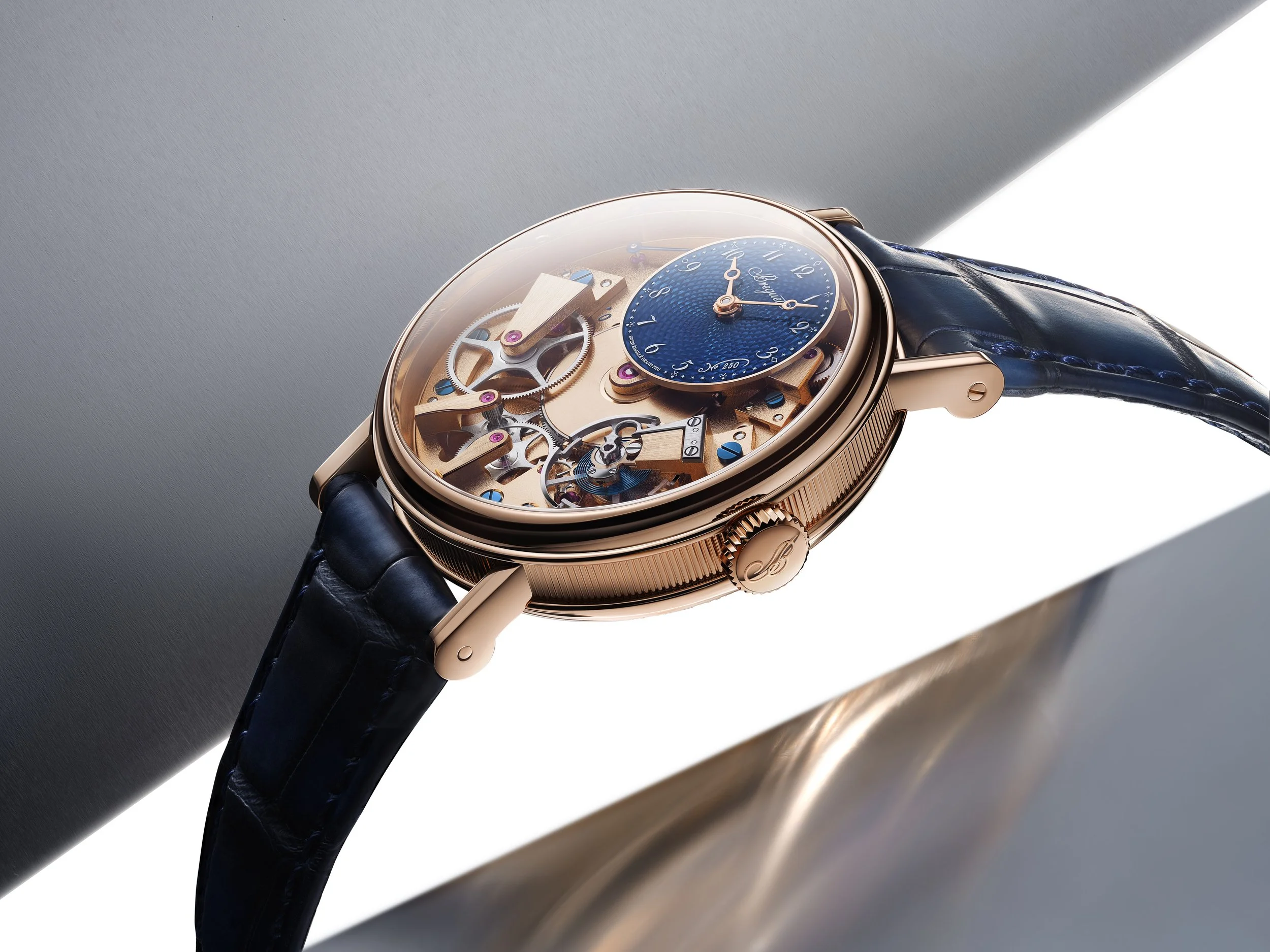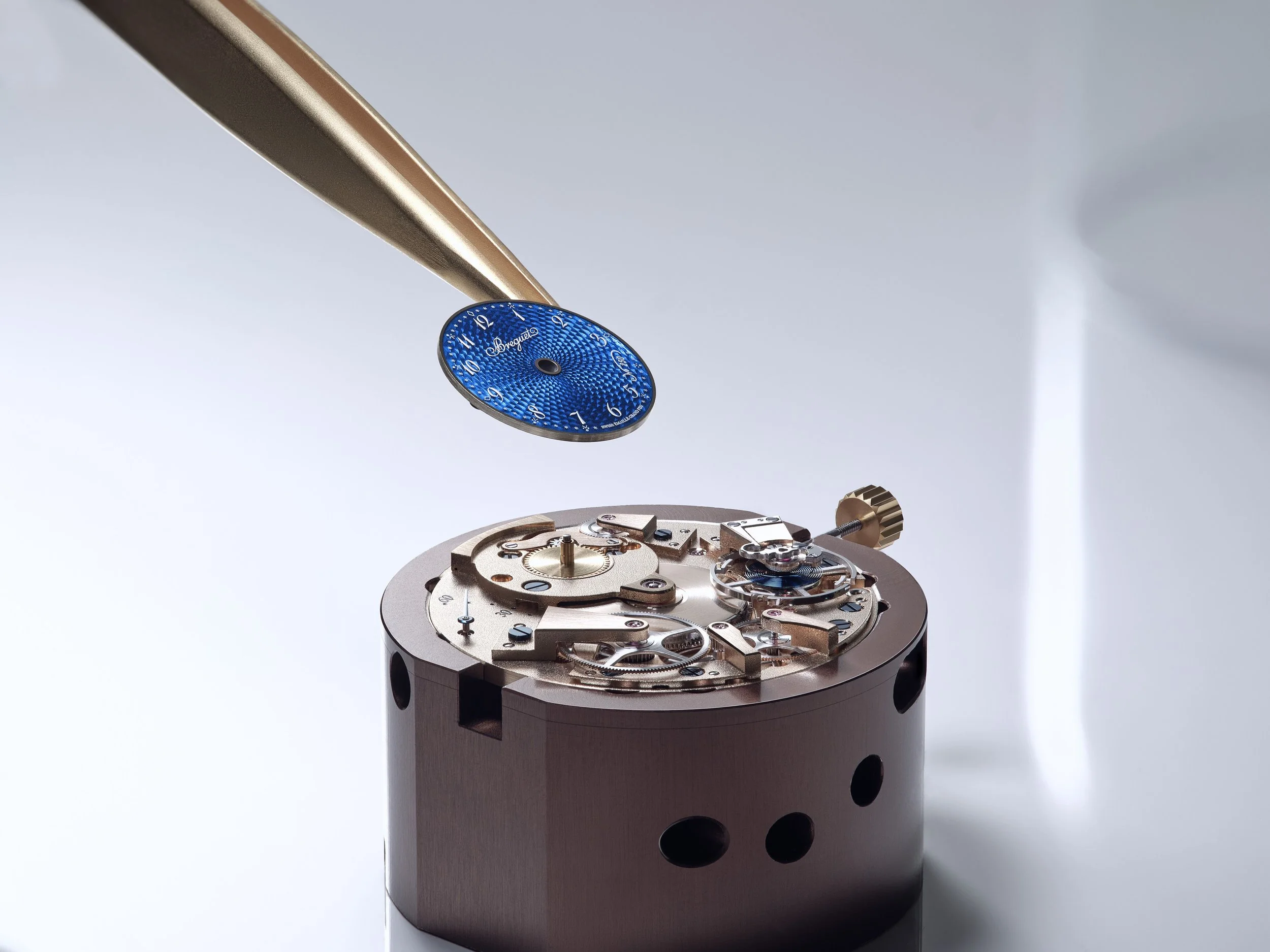Breguet Tradition Seconde Rétrograde 7035
Crafted for Eternity
PRESS RELEASE | 940 WORDS | 9 MINUTE READ
100% Breguet style
With a unique architecture that brings its precision mechanism to the fore, crowned by a hand-made, enamel dial, the Tradition 7035 epitomises Breguet’s 250 years of technical and aesthetic innovation.
Breguet gold, an exclusive alloy presented for Breguet’s 250th anniversary, now enriches the case of the Tradition 7035. This special edition emphasises the unique architecture of the movement, and features a guilloché dial in translucent blue, grand feu enamel displaying the hours and minutes, alongside a retrograde seconds display discretely positioned between 10 and 11 o’clock.
Photo Courtesy - Breguet
Abraham-Louis Breguet or the birth of an international network
In addition to his technical innovations, A.-L. Breguet worked constantly to widen access to timekeeping innovations, enabling an increasingly broad and cosmopolitan clientele to know the time at any moment. His intuition, combined with a desire to produce in small series, led him, in 1796, to propose Souscription watches. These were simple and robust, single hand timepieces, sold in a distinctive way. Clients were introduced to Sou scription watches by means of an advertising leaflet, a first for its time and the precursor of the first commercial catalogue, which Breguet would go on to create. Another particularity was the use of a deposit: Having selected the timepiece from the leaflet, the client would pay a quarter of the price when the order was placed.
In 1799, he introduced Tact watches, which further enhanced his status amongst his peers and clients. Featuring an external hand and markings placed around the case they allowed the time to be “read” by touch, in perfect discretion.
The synthesis of these two timepieces is the Tradition collection, born in 2005. This line features a unique architectural structure, exposing the bridges, gears and mechanisms of this marvel of precision microengineering. Inspired by the work of A.-L. Breguet, this easily recognisable configuration offers the same uninterrupted view of the inner workings of the watch that a watch maker sees when working on a watch.
“ Breguet is among the Haute Horlogerie Houses to have retained its visual identity from its foundation to the present day.
- Gregory Kissling, CEO
Tradition 7035, respecting savoir-faire
Specially designed for Breguet’s 250th anniversary, this variation of the Tradition 7037 remains faithful to the Tradition collection’s geometric codes, combining Breguet’s technical and aesthetic expertise with meticulous in-house hand-finishing.
Breguet gold and Breguet blue: two “signature” colour codes
The Tradition collection incorporates for the first time two “in-house” colour codes: Breguet gold and Breguet blue.
Gold, silver, copper and palladium are skillfully fused into an alloy that radiates a warm, golden glow: Breguet gold. This exclusive alloy, created by Breguet, was introduced earlier this year with the Classique Souscription 2025 watch. The 38 mm diameter case for the Tradition 7035 has been crafted from this new alloy. A specially-developed plating treatment ensures that the mainplate and bridges are of the same hue as the case. The silver-coloured gears, blued screws and ruby-red jewels provide visual contrast and further accentuate the radiance of Breguet gold. The bridges of this new anniversary model feature, for the first time in the Tradition collection, a silky, hand-applied satin finish on their upper surfaces.
The striking focal point of this model is the finely engine turned dial, resplendent in Breguet blue. The chosen motive is the Quai de l’Horloge. Its tinted, translucent, grand feu enamel is of the same deep, blue as the retrograde seconds hand and screws, which are made of blued steel. In contrasting silver, the Breguet Arabic numerals, the minute track, with its stylised fleurs-de lis, and the unique serial number at 4 o’clock stand out effortlessly against the shimmering azure of the enamel.
Quai de l’Horloge: a unique guilloché decoration
A decorative technique that was often used on watch cases, guilloché has become an art in its own right. A.-L. Breguet was the first to use this technique to delineate the different displays on watch dials, and it remains, to this day, one of Breguet’s core areas of expertise.
Breguet currently owns the largest collection of working guilloché lathes in the world. These carefully renovated period machines can be used to create a wide range of motifs, from the most traditional, such as the Clou de Paris, to the most contemporary, the new Quai de l’Horloge design, which has been incorporated on the dial of this Tradition model.
This new guilloché motif was inspired by the graceful lines of the Seine as it flows around the Île de la Cité, where A.-L. Breguet’s workshop once stood, and the Île Saint Louis, both in the heart of Paris. The precise contours of this motif are modelled on the Turgot map, a highly-detailed, perspective view of the city of Paris produced in the eighteenth century. For its time it was remarkably accurate: it included all the streets, buildings and even every tree in the centre of Paris.
Crescent moon-shaped oscillating weight: a tribute to watchmaking genius
The back of the new Tradition 7035 reveals a golden landscape as fascinating as the front. The oscillating weight spins above the bridges’ satin-finished surfaces, which provide an elegant contrast to the shot-blasted mainplate below.
The crescent moon-shaped weight, made of vertical brushed platinum, is reminiscent of those used in A.-L. Breguet’s time. He established the use of platinum in watchmaking, using it to optimise the automatic winding of what he referred to as his “perpétuelle” watches, one of the first innovations from this master watchmaker.
A discrete “Pt950” engraved on the weight’s upper left-hand flank acts as a reassuring gauge of quality, as well as a knowing nod to Breguet’s patrimony.
For further information, visit breguet.com









